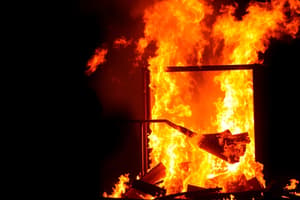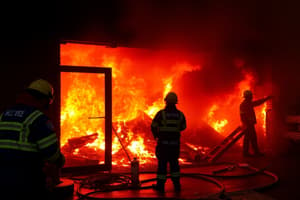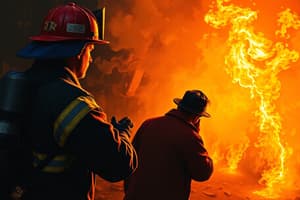Podcast
Questions and Answers
What is the NFPA regulation on fire and explosive investigation?
What is the NFPA regulation on fire and explosive investigation?
NFPA 921
What is the scientific method?
What is the scientific method?
A seven step process to test one or more hypotheses against the evidence collected during the investigation.
What are fire effects?
What are fire effects?
Observable changes found on objects, surfaces, and construction materials as a result of heat, flame, smoke, and other production of combustion.
What are fire patterns?
What are fire patterns?
What is depth of char?
What is depth of char?
What is a competent ignition source?
What is a competent ignition source?
How do fire investigators determine fire cause?
How do fire investigators determine fire cause?
What are the four classifications of fire cause?
What are the four classifications of fire cause?
What makes a fire undetermined?
What makes a fire undetermined?
What are the six types of evidence?
What are the six types of evidence?
What is a serial arsonist?
What is a serial arsonist?
What is a spree arsonist?
What is a spree arsonist?
What is a mass arsonist?
What is a mass arsonist?
What are the three types of youth firesetters and their ages?
What are the three types of youth firesetters and their ages?
Where do child firesetters typically light fires?
Where do child firesetters typically light fires?
Where do juvenile firesetters light fires?
Where do juvenile firesetters light fires?
Where do adolescent firesetters light fires?
Where do adolescent firesetters light fires?
What are the six motivations for arson?
What are the six motivations for arson?
Why should firefighters understand the basic principles of fire investigation?
Why should firefighters understand the basic principles of fire investigation?
Who usually performs fire investigation?
Who usually performs fire investigation?
Which is part of the primary purpose of fire investigation?
Which is part of the primary purpose of fire investigation?
Which police powers do fire investigators have?
Which police powers do fire investigators have?
Which federal agency makes individual agents available to assist local jurisdictions with fire investigations?
Which federal agency makes individual agents available to assist local jurisdictions with fire investigations?
Which is one of the four classifications of fire cause?
Which is one of the four classifications of fire cause?
Which court case ruled on the need for warrants in fire investigation?
Which court case ruled on the need for warrants in fire investigation?
What is the term for an ignition source that has enough heat energy to ignite the fuel and remains in contact with it long enough to cause ignition?
What is the term for an ignition source that has enough heat energy to ignite the fuel and remains in contact with it long enough to cause ignition?
A pot left unattended on a stove that catches fire is an example of an act of?
A pot left unattended on a stove that catches fire is an example of an act of?
Which is the process used in fire investigation to determine if and where electrical circuits were energized at the time of the fire?
Which is the process used in fire investigation to determine if and where electrical circuits were energized at the time of the fire?
The scientific method recommended by the NFPA for determining cause and origin consists of _______ steps.
The scientific method recommended by the NFPA for determining cause and origin consists of _______ steps.
Which is the fourth step in the NFPA's scientific method for determining cause and origin?
Which is the fourth step in the NFPA's scientific method for determining cause and origin?
Which NFPA standard establishes job performance requirements for fire investigators?
Which NFPA standard establishes job performance requirements for fire investigators?
Where does the fire investigation process usually begin?
Where does the fire investigation process usually begin?
Which pattern of char on a wall suggests that the fire spread upward from the base?
Which pattern of char on a wall suggests that the fire spread upward from the base?
Which term means the process of carefully looking for evidence in the debris following a fire?
Which term means the process of carefully looking for evidence in the debris following a fire?
Which term refers to all of the information gathered and used by an investigator in determining the cause of a fire?
Which term refers to all of the information gathered and used by an investigator in determining the cause of a fire?
Which kind of evidence is used to validate a theory or show how something could have occurred?
Which kind of evidence is used to validate a theory or show how something could have occurred?
Which kind of evidence includes facts that can be observed or reported firsthand?
Which kind of evidence includes facts that can be observed or reported firsthand?
Ideally, when should overhaul operations begin?
Ideally, when should overhaul operations begin?
In general, what is the primary responsibility of firefighters in fire investigation?
In general, what is the primary responsibility of firefighters in fire investigation?
Who has the legal responsibility to determine the cause of fire in most jurisdictions?
Who has the legal responsibility to determine the cause of fire in most jurisdictions?
Study Notes
Fire Investigation Regulations and Principles
- NFPA 921 guides fire and explosive investigations, providing recognized standards and methods.
- The scientific method comprises seven steps for testing hypotheses against collected evidence.
Fire Characteristics
- Fire Effects: Observable changes in materials due to heat, flame, and smoke.
- Fire Patterns: Indicate the duration and temperature variations experienced by objects.
- Depth of Char: Once thought to measure exposure time to fire, now viewed as less definitive.
Ignition Sources and Fire Causes
- A Competent Ignition Source has sufficient energy to ignite the first fuel source effectively.
- Identifying fire causes involves determining the ignition source, the first fuel ignited, the oxidizing agent, and the ignition sequence.
- Four classifications of fire cause are Accidental, Natural, Incendiary, and Undetermined.
- A fire is classified as Undetermined when certainty in the hypothesis falls below 50%.
Types of Evidence in Investigations
- Six evidence types include Physical, Demonstrative, Documentary, Testimonial, Direct, and Circumstantial evidence.
Arson Types
- Serial Arsonist: Sets three or more fires with emotional pauses in between.
- Spree Arsonist: Sets multiple fires in various locations without significant cooling-off periods.
- Mass Arsonist: Ignites several fires at or near the same site within a short timeframe.
Youth Firesetters
- Youth firesetters are categorized into three age groups:
- Child (ages 2-6)
- Juvenile (ages 7-13)
- Adolescent (ages 14-16).
- Child firesetters typically light fires in hidden areas, while juvenile firesetters often target homes or schools. Adolescent firesetters usually choose broader public spaces.
Motivations for Arson
- Key motivations include vandalism, excitement, revenge, crime concealment, profit, and extremism.
Role of Firefighters in Investigations
- Firefighters should understand investigation principles to effectively observe and preserve evidence.
- Fire investigations are typically conducted by individuals trained according to NFPA standards, often under the fire chief's legal authority.
Investigative Techniques and Court Decisions
- Arc Mapping is a technique used to determine electrical circuit activity during a fire.
- The Michigan v. Tyler case is pivotal for establishing the need for warrants in fire investigations.
Evidence Collection and Analysis
- Observing physical evidence is crucial, and demonstrative evidence can clarify theories.
- Direct evidence includes firsthand accounts and observations crucial for validation.
- Overhaul operations should commence only after the fire investigator has assessed the scene to avoid disrupting evidence.
Fire Investigation Sequence
- The investigation begins externally, with the V-shaped char pattern indicating upward fire spread from the base.
- Evidence gathering is vital, and the complexity of the fire scene can require detailed examination techniques like "digging out" to uncover hidden evidence.
Studying That Suits You
Use AI to generate personalized quizzes and flashcards to suit your learning preferences.
Description
Test your knowledge on fire investigation topics with these flashcards from Chapter 28. Learn about NFPA regulations, the scientific method in fire investigations, and the effects of fire on materials. Perfect for fire safety and investigation studies.



